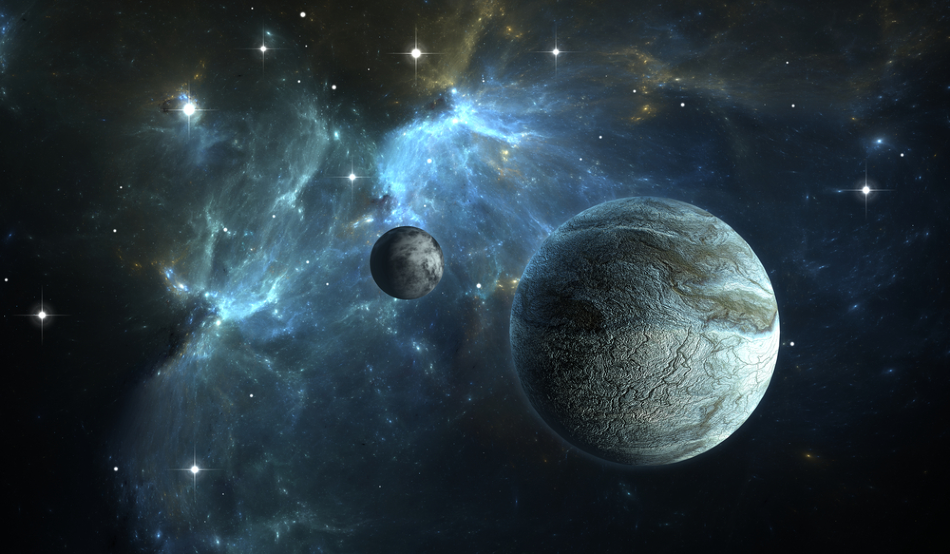Feb 16 2008

Image Credit: Jurik Peter/Shutterstock.com
Article updated on 03/03/20 by Ben Pilkington
Harnessing the work in gravitational microlensing, supercomputer modeling and adaptive optics pioneered at the Lawrence Livermore National Laboratory (LLNL) at the University of California, Berkeley (United States), scientists have discovered two new planets in a solar system very much like our own.
A team of international scientists has discovered a solar system nearly 5,000 light-years away that contains two scaled-down gas giant planets. While they are about half the distance from their source star as Jupiter and Saturn are from our sun, the orbits of the two new planets are the same distance apart as Jupiter’s and Saturn’s.
Finding Exoplanetary Systems Through Microlensing
The researchers used a technique known as gravitational microlensing to discover the new system. This exploits the gravitational lens effect, in which a massive object bends the light from a bright object behind it. Because this is just the fifth exoplanetary system found via microlensing, the finding suggests that our galaxy hosts many solar systems like our own.
This is the first time something analogous to our solar system has been found. This indicates that our kind of planetary system is relatively common and that in and of itself is exciting.
Kem Cook, Researcher, Lawrence Livermore National Laboratory
Cook is a pioneer in gravitational microlensing.
The new finding was published in 2008 in the journal, Science.
The two planets were seen when the star they orbit crossed in front of a more distant star as seen from Earth, causing the gravitational lens effect. For two weeks, from late March to early April 2006, the nearer star’s gravity magnified the light shining from the farther star. The planets altered this magnification in an identifiable manner.
The Gravitational Microlensing Planet Search
The gravitational microlensing planet search method is sensitive to multiple-planet systems containing analogs of all of our solar system planets except Mercury.
The new planets resemble a scaled-down version of our solar system, because the mass ratio, separation ratio and equilibrium temperatures are similar to those of Jupiter and Saturn. The planets’ masses are about 71 percent and 90 percent of Jupiter and Saturn, respectively, while their sun is about 50 percent as massive as our sun.
It looks more like our solar system than any other system we’ve seen so far. This system resembles our own and it has room in it for a planet like Earth.
Bruce Macintosh, Author, Lawrence Livermore National Laboratory
The Optical Gravitational Lensing Experiment
The Optical Gravitational Lensing Experiment (OGLE), dubbed OGLE-2006-BLG-109, first detected the event on March 28, 2006. The Microlensing Follow Up Network (MicroFUN), led by Andrew Gould, professor of astronomy at Ohio State, then joined with OGLE to organize astronomers worldwide to gather observations of it. Analyzing the data in real-time, Ohio State Professor Scott Gaudi (the lead author) realized that this observation was likely to be a two-planet event, instead of the hoped-for single-planet event, making the discovery even more exciting.
To confirm the existence of the two planets, Livermore researchers went a step further. LLNL’s Sergei Nikolaev used the lab’s supercomputer Zeus to constrain the parameters of the microlensing model and allow the planetary motions to be included in the solution in a reasonable amount of time. The result was confirmation of the existence of the two scaled-down Jupiter- and Saturn-like planets. Notre Dame University’s David Bennett (another author of the paper) developed the code for Zeus and helped in the analysis.
The Adaptive Optics System
Macintosh used the adaptive optics (AO) system at the Keck Observatory in Hawaii to isolate the lens star (the star of the new planetary system) from other stars in the extremely crowded region toward the center of our galaxy. AO allows astronomers to minimize the blurring effects of Earth’s atmosphere, producing images with unprecedented detail and resolution. The Keck AO image allowed a direct measurement of the source system’s brightness and color, helping to constrain the source system’s mass. Cook, in addition to belonging to one of the follow-up teams (Probing Lensing Anomalies Network, or PLANET), analyzed the Keck AO data.
The discovery relied on 11 different ground-based telescopes in countries around the world, including New Zealand, Tasmania, Israel, Chile, the Canary Islands and the United States.
The planetary system represents a scaled-down version of our solar system, with a less massive sun. However, the scaling down is consistent with the core accretion paradigm in which giant planets form near the snow line (the point in the protoplanetary disk beyond which ices are stable). Planet mass decreases as the distance beyond the snow line increases.
Acknowledgments
Other co-authors include scientists from Ohio State University, Notre Dame University, Warsaw University Observatory, Auckland Observatory, Tel-Aviv University, Farm Cove Observatory, Mt. John Observatory, Princeton University Observatory, Universidad de Concepción, University of Cambridge, Chungbuk National University, Korea Astronomy and Space Science Institute, Campo Catino Astronomical Observatory, Nagoya University, Massey University, University of Auckland, University of Canterbury, Victoria University, Konan University, Nagano National College of Technology, University of Manchester, Tokyo Metropolitan College of Aeronautics, University of Exeter, Université Pierre et Marie Curie, Liverpool John Moores University, University of St. Andrews, University of Tasmania, Université Paul Sabatier-Toulouse, Dartmouth College and the University of Oxford.
Source
- Lawrence Livermore National Laboratory